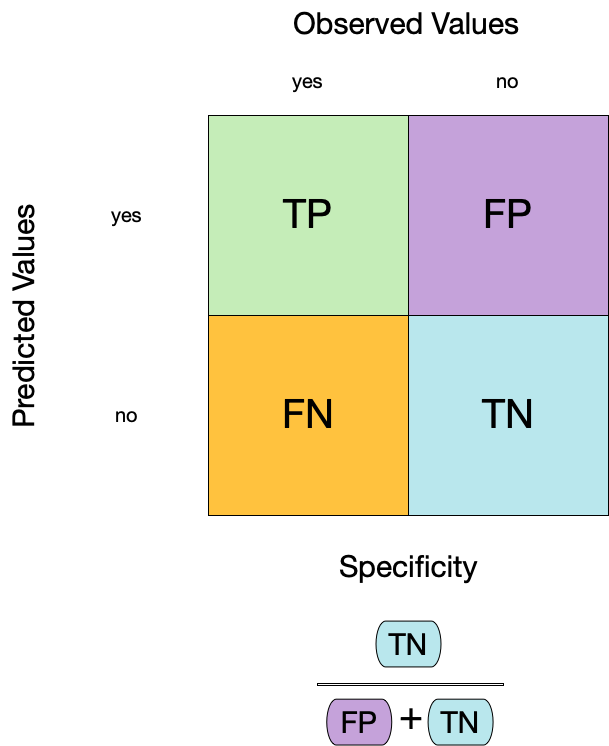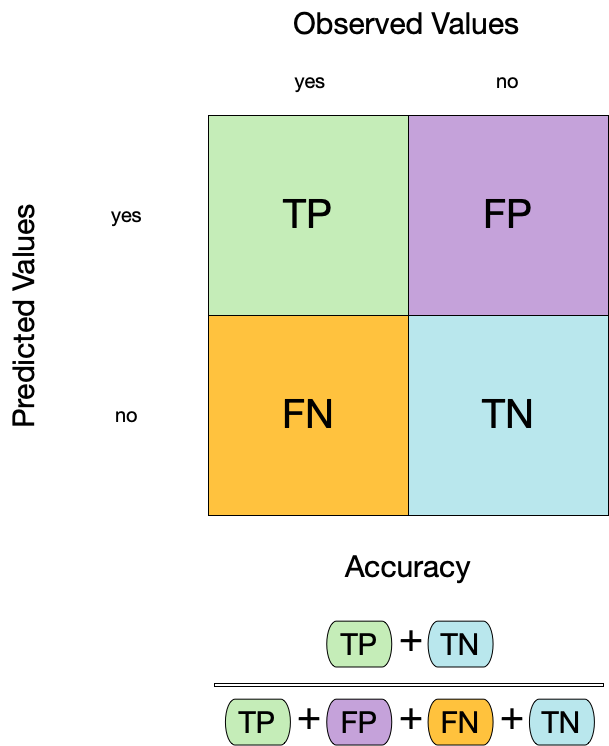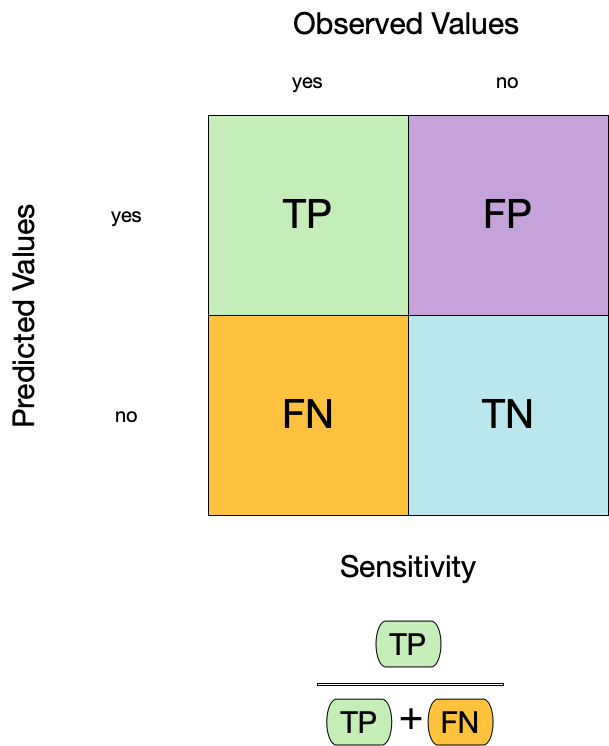augment(forested_fit, new_data = forested_train)
#> # A tibble: 8,749 × 22
#> .pred_class .pred_Yes .pred_No forested year elevation eastness roughness
#> <fct> <dbl> <dbl> <fct> <dbl> <dbl> <dbl> <dbl>
#> 1 Yes 0.931 0.0690 Yes 1997 66 82 10
#> 2 Yes 0.983 0.0172 No 1997 284 -99 58
#> 3 Yes 0.960 0.0401 Yes 2022 130 86 15
#> 4 Yes 0.870 0.130 Yes 2021 202 -55 3
#> 5 Yes 0.823 0.177 Yes 1995 75 -89 1
#> 6 Yes 0.758 0.242 No 1995 110 -53 5
#> 7 Yes 0.823 0.177 Yes 2022 111 73 12
#> 8 No 0.467 0.533 Yes 1997 230 96 14
#> 9 Yes 0.983 0.0172 Yes 2002 160 -88 13
#> 10 Yes 0.871 0.129 Yes 2020 39 9 6
#> # ℹ 8,739 more rows
#> # ℹ 14 more variables: tree_no_tree <fct>, dew_temp <dbl>, precip_annual <dbl>,
#> # temp_annual_mean <dbl>, temp_annual_min <dbl>, temp_annual_max <dbl>,
#> # temp_january_min <dbl>, vapor_min <dbl>, vapor_max <dbl>,
#> # canopy_cover <dbl>, lon <dbl>, lat <dbl>, land_type <fct>, county <fct>4 - Evaluating models
Introduction to Machine Learning in R with tidymodels
Looking at predictions
Confusion matrix ![]()

Confusion matrix ![]()
Confusion matrix ![]()
Your turn

How would you combine TP, TN, FP, and FN into one number to describe how often the model is correct?

05:00
Metrics for model performance ![]()
Dangers of accuracy ![]()
We need to be careful of using accuracy() since it can give “good” performance by only predicting one way with imbalanced data:
Metrics for model performance ![]()
Metrics for model performance ![]()

Metrics for model performance ![]()
We can use metric_set() to combine multiple calculations into one
forested_metrics <- metric_set(accuracy, specificity, sensitivity)
augment(forested_fit, new_data = forested_train) |>
forested_metrics(truth = forested, estimate = .pred_class)
#> # A tibble: 3 × 3
#> .metric .estimator .estimate
#> <chr> <chr> <dbl>
#> 1 accuracy binary 0.851
#> 2 specificity binary 0.642
#> 3 sensitivity binary 0.931Metrics for model performance ![]()
Metrics and metric sets work with grouped data frames!
Your turn

Apply the forested_metrics metric set to augment()
output grouped by tree_no_tree.
Do any metrics differ substantially between groups?
05:00
Two class data
These metrics assume that we know the threshold for converting “soft” probability predictions into “hard” class predictions.
Is a 50% threshold good?
What happens if we say that we need to be 80% sure to declare an event?
- sensitivity ⬇️, specificity ⬆️
What happens for a 20% threshold?
- sensitivity ⬆️, specificity ⬇️
Varying the threshold
ROC curves
For an ROC (receiver operator characteristic) curve, we plot
- the false positive rate (1 - specificity) on the x-axis
- the true positive rate (sensitivity) on the y-axis
with sensitivity and specificity calculated at all possible thresholds.
ROC curves
We can use the area under the ROC curve as a classification metric:
- ROC AUC = 1 💯
- ROC AUC = 1/2 😢
ROC curves ![]()
# Assumes _first_ factor level is event; there are options to change that
augment(forested_fit, new_data = forested_train) |>
roc_curve(truth = forested, .pred_Yes) |>
slice(1, 20, 50)
#> # A tibble: 3 × 3
#> .threshold specificity sensitivity
#> <dbl> <dbl> <dbl>
#> 1 -Inf 0 1
#> 2 0.143 0.267 0.990
#> 3 0.385 0.571 0.951
augment(forested_fit, new_data = forested_train) |>
roc_auc(truth = forested, .pred_Yes)
#> # A tibble: 1 × 3
#> .metric .estimator .estimate
#> <chr> <chr> <dbl>
#> 1 roc_auc binary 0.881ROC curve plot ![]()
Your turn

Compute and plot an ROC curve for your current model.
What data are being used for this ROC curve plot?
05:00
Brier score formula
What if we don’t turn predicted probabilities into class predictions?
The Brier score is analogous to the mean squared error in regression models:
\[ Brier_{class} = \frac{1}{NC}\sum_{i=1}^N\sum_{k=1}^C (y_{ik} - \hat{p}_{ik})^2 \]
Brier score
Smaller values are better, for binary classification the “bad model threshold” is about 0.25.
Separation vs calibration
The ROC captures separation.
The Brier score captures calibration.
⚠️ DANGERS OF OVERFITTING ⚠️
Dangers of overfitting

Dangers of overfitting ⚠️

Dangers of overfitting ⚠️ ![]()
forested_fit |>
augment(forested_train)
#> # A tibble: 8,749 × 22
#> .pred_class .pred_Yes .pred_No forested year elevation eastness roughness
#> <fct> <dbl> <dbl> <fct> <dbl> <dbl> <dbl> <dbl>
#> 1 Yes 0.931 0.0690 Yes 1997 66 82 10
#> 2 Yes 0.983 0.0172 No 1997 284 -99 58
#> 3 Yes 0.960 0.0401 Yes 2022 130 86 15
#> 4 Yes 0.870 0.130 Yes 2021 202 -55 3
#> 5 Yes 0.823 0.177 Yes 1995 75 -89 1
#> 6 Yes 0.758 0.242 No 1995 110 -53 5
#> 7 Yes 0.823 0.177 Yes 2022 111 73 12
#> 8 No 0.467 0.533 Yes 1997 230 96 14
#> 9 Yes 0.983 0.0172 Yes 2002 160 -88 13
#> 10 Yes 0.871 0.129 Yes 2020 39 9 6
#> # ℹ 8,739 more rows
#> # ℹ 14 more variables: tree_no_tree <fct>, dew_temp <dbl>, precip_annual <dbl>,
#> # temp_annual_mean <dbl>, temp_annual_min <dbl>, temp_annual_max <dbl>,
#> # temp_january_min <dbl>, vapor_min <dbl>, vapor_max <dbl>,
#> # canopy_cover <dbl>, lon <dbl>, lat <dbl>, land_type <fct>, county <fct>We call this “resubstitution” or “repredicting the training set”
Dangers of overfitting ⚠️ ![]()
We call this a “resubstitution estimate”
Dangers of overfitting ⚠️ ![]()
Dangers of overfitting ⚠️ ![]()
⚠️ Remember that we’re demonstrating overfitting
⚠️ Don’t use the test set until the end of your modeling analysis
Your turn

Use augment() and a metric function to compute a classification metric like roc_auc().
Compute the metrics for both training and testing data to demonstrate overfitting!
Notice the evidence of overfitting! ⚠️
05:00
Dangers of overfitting ⚠️ ![]()
What if we want to compare more models?
And/or more model configurations?
And we want to understand if these are important differences?
The testing data are precious 💎
How can we use the training data to compare and evaluate different models? 🤔
Cross-validation
Cross-validation
Your turn

If we use 10 folds, what percent of the training data
- ends up in analysis
- ends up in assessment
for each fold?
03:00
Cross-validation ![]()
vfold_cv(forested_train) # v = 10 is default
#> # 10-fold cross-validation
#> # A tibble: 10 × 2
#> splits id
#> <list> <chr>
#> 1 <split [7874/875]> Fold01
#> 2 <split [7874/875]> Fold02
#> 3 <split [7874/875]> Fold03
#> 4 <split [7874/875]> Fold04
#> 5 <split [7874/875]> Fold05
#> 6 <split [7874/875]> Fold06
#> 7 <split [7874/875]> Fold07
#> 8 <split [7874/875]> Fold08
#> 9 <split [7874/875]> Fold09
#> 10 <split [7875/874]> Fold10Cross-validation ![]()
What is in this?
Cross-validation ![]()
Cross-validation ![]()
We’ll use this setup:
set.seed(123)
forested_folds <- vfold_cv(forested_train, v = 10)
forested_folds
#> # 10-fold cross-validation
#> # A tibble: 10 × 2
#> splits id
#> <list> <chr>
#> 1 <split [7874/875]> Fold01
#> 2 <split [7874/875]> Fold02
#> 3 <split [7874/875]> Fold03
#> 4 <split [7874/875]> Fold04
#> 5 <split [7874/875]> Fold05
#> 6 <split [7874/875]> Fold06
#> 7 <split [7874/875]> Fold07
#> 8 <split [7874/875]> Fold08
#> 9 <split [7874/875]> Fold09
#> 10 <split [7875/874]> Fold10Set the seed when creating resamples
We are equipped with metrics and resamples!
Fit our model to the resamples
forested_res <- fit_resamples(forested_wflow, forested_folds)
forested_res
#> # Resampling results
#> # 10-fold cross-validation
#> # A tibble: 10 × 4
#> splits id .metrics .notes
#> <list> <chr> <list> <list>
#> 1 <split [7874/875]> Fold01 <tibble [3 × 4]> <tibble [0 × 4]>
#> 2 <split [7874/875]> Fold02 <tibble [3 × 4]> <tibble [0 × 4]>
#> 3 <split [7874/875]> Fold03 <tibble [3 × 4]> <tibble [0 × 4]>
#> 4 <split [7874/875]> Fold04 <tibble [3 × 4]> <tibble [0 × 4]>
#> 5 <split [7874/875]> Fold05 <tibble [3 × 4]> <tibble [0 × 4]>
#> 6 <split [7874/875]> Fold06 <tibble [3 × 4]> <tibble [0 × 4]>
#> 7 <split [7874/875]> Fold07 <tibble [3 × 4]> <tibble [0 × 4]>
#> 8 <split [7874/875]> Fold08 <tibble [3 × 4]> <tibble [0 × 4]>
#> 9 <split [7874/875]> Fold09 <tibble [3 × 4]> <tibble [0 × 4]>
#> 10 <split [7875/874]> Fold10 <tibble [3 × 4]> <tibble [0 × 4]>Evaluating model performance ![]()
forested_res |>
collect_metrics()
#> # A tibble: 3 × 6
#> .metric .estimator mean n std_err .config
#> <chr> <chr> <dbl> <int> <dbl> <chr>
#> 1 accuracy binary 0.704 10 0.00653 pre0_mod0_post0
#> 2 brier_class binary 0.214 10 0.00349 pre0_mod0_post0
#> 3 roc_auc binary 0.692 10 0.00496 pre0_mod0_post0We can reliably measure performance using only the training data 🎉
Comparing metrics ![]()
How do the metrics from resampling compare to the metrics from training and testing?
The ROC AUC previously was
- 0.88 for the training set
- 0.7 for test set
Remember that:
⚠️ the training set gives you overly optimistic metrics
⚠️ the test set is precious
Evaluating model performance ![]()
# Save the assessment set results
ctrl_forested <- control_resamples(save_pred = TRUE)
forested_res <- fit_resamples(forested_wflow, forested_folds, control = ctrl_forested)
forested_res
#> # Resampling results
#> # 10-fold cross-validation
#> # A tibble: 10 × 5
#> splits id .metrics .notes .predictions
#> <list> <chr> <list> <list> <list>
#> 1 <split [7874/875]> Fold01 <tibble [3 × 4]> <tibble [0 × 4]> <tibble>
#> 2 <split [7874/875]> Fold02 <tibble [3 × 4]> <tibble [0 × 4]> <tibble>
#> 3 <split [7874/875]> Fold03 <tibble [3 × 4]> <tibble [0 × 4]> <tibble>
#> 4 <split [7874/875]> Fold04 <tibble [3 × 4]> <tibble [0 × 4]> <tibble>
#> 5 <split [7874/875]> Fold05 <tibble [3 × 4]> <tibble [0 × 4]> <tibble>
#> 6 <split [7874/875]> Fold06 <tibble [3 × 4]> <tibble [0 × 4]> <tibble>
#> 7 <split [7874/875]> Fold07 <tibble [3 × 4]> <tibble [0 × 4]> <tibble>
#> 8 <split [7874/875]> Fold08 <tibble [3 × 4]> <tibble [0 × 4]> <tibble>
#> 9 <split [7874/875]> Fold09 <tibble [3 × 4]> <tibble [0 × 4]> <tibble>
#> 10 <split [7875/874]> Fold10 <tibble [3 × 4]> <tibble [0 × 4]> <tibble>Evaluating model performance ![]()
# Save the assessment set results
forested_preds <- collect_predictions(forested_res)
forested_preds
#> # A tibble: 8,749 × 7
#> .pred_class .pred_Yes .pred_No id forested .row .config
#> <fct> <dbl> <dbl> <chr> <fct> <int> <chr>
#> 1 Yes 0.953 0.0473 Fold01 No 2 pre0_mod0_post0
#> 2 Yes 0.6 0.4 Fold01 No 6 pre0_mod0_post0
#> 3 Yes 0.848 0.152 Fold01 Yes 7 pre0_mod0_post0
#> 4 Yes 0.941 0.0588 Fold01 Yes 36 pre0_mod0_post0
#> 5 Yes 0.895 0.105 Fold01 No 38 pre0_mod0_post0
#> 6 Yes 1 0 Fold01 Yes 58 pre0_mod0_post0
#> 7 No 0.187 0.812 Fold01 No 69 pre0_mod0_post0
#> 8 Yes 0.905 0.0952 Fold01 Yes 71 pre0_mod0_post0
#> 9 Yes 0.907 0.0930 Fold01 Yes 74 pre0_mod0_post0
#> 10 Yes 0.904 0.0962 Fold01 Yes 80 pre0_mod0_post0
#> # ℹ 8,739 more rowsEvaluating model performance ![]()
forested_preds |>
group_by(id) |>
forested_metrics(truth = forested, estimate = .pred_class)
#> # A tibble: 30 × 4
#> id .metric .estimator .estimate
#> <chr> <chr> <chr> <dbl>
#> 1 Fold01 accuracy binary 0.729
#> 2 Fold02 accuracy binary 0.685
#> 3 Fold03 accuracy binary 0.687
#> 4 Fold04 accuracy binary 0.711
#> 5 Fold05 accuracy binary 0.736
#> 6 Fold06 accuracy binary 0.670
#> 7 Fold07 accuracy binary 0.699
#> 8 Fold08 accuracy binary 0.710
#> 9 Fold09 accuracy binary 0.699
#> 10 Fold10 accuracy binary 0.719
#> # ℹ 20 more rowsWhere are the fitted models? ![]()
forested_res
#> # Resampling results
#> # 10-fold cross-validation
#> # A tibble: 10 × 5
#> splits id .metrics .notes .predictions
#> <list> <chr> <list> <list> <list>
#> 1 <split [7874/875]> Fold01 <tibble [3 × 4]> <tibble [0 × 4]> <tibble>
#> 2 <split [7874/875]> Fold02 <tibble [3 × 4]> <tibble [0 × 4]> <tibble>
#> 3 <split [7874/875]> Fold03 <tibble [3 × 4]> <tibble [0 × 4]> <tibble>
#> 4 <split [7874/875]> Fold04 <tibble [3 × 4]> <tibble [0 × 4]> <tibble>
#> 5 <split [7874/875]> Fold05 <tibble [3 × 4]> <tibble [0 × 4]> <tibble>
#> 6 <split [7874/875]> Fold06 <tibble [3 × 4]> <tibble [0 × 4]> <tibble>
#> 7 <split [7874/875]> Fold07 <tibble [3 × 4]> <tibble [0 × 4]> <tibble>
#> 8 <split [7874/875]> Fold08 <tibble [3 × 4]> <tibble [0 × 4]> <tibble>
#> 9 <split [7874/875]> Fold09 <tibble [3 × 4]> <tibble [0 × 4]> <tibble>
#> 10 <split [7875/874]> Fold10 <tibble [3 × 4]> <tibble [0 × 4]> <tibble>🗑️
Alternate resampling schemes
Bootstrapping
Bootstrapping ![]()
set.seed(3214)
bootstraps(forested_train)
#> # Bootstrap sampling
#> # A tibble: 25 × 2
#> splits id
#> <list> <chr>
#> 1 <split [8749/3218]> Bootstrap01
#> 2 <split [8749/3264]> Bootstrap02
#> 3 <split [8749/3220]> Bootstrap03
#> 4 <split [8749/3208]> Bootstrap04
#> 5 <split [8749/3230]> Bootstrap05
#> 6 <split [8749/3197]> Bootstrap06
#> 7 <split [8749/3193]> Bootstrap07
#> 8 <split [8749/3226]> Bootstrap08
#> 9 <split [8749/3243]> Bootstrap09
#> 10 <split [8749/3233]> Bootstrap10
#> # ℹ 15 more rowsThe whole game - status update

Your turn

Create:
- Monte Carlo Cross-Validation sets
- validation set
(use the reference guide to find the functions)
Don’t forget to set a seed when you resample!
05:00
Monte Carlo Cross-Validation ![]()
set.seed(322)
mc_cv(forested_train, times = 10)
#> # Monte Carlo cross-validation (0.75/0.25) with 10 resamples
#> # A tibble: 10 × 2
#> splits id
#> <list> <chr>
#> 1 <split [6561/2188]> Resample01
#> 2 <split [6561/2188]> Resample02
#> 3 <split [6561/2188]> Resample03
#> 4 <split [6561/2188]> Resample04
#> 5 <split [6561/2188]> Resample05
#> 6 <split [6561/2188]> Resample06
#> 7 <split [6561/2188]> Resample07
#> 8 <split [6561/2188]> Resample08
#> 9 <split [6561/2188]> Resample09
#> 10 <split [6561/2188]> Resample10Validation set ![]()
A validation set is just another type of resample
Decision tree 🌳
Random forest 🌳🌲🌴🌵🌴🌳🌳🌴🌲🌵🌴🌲🌳🌴🌳🌵🌵🌴🌲🌲🌳🌴🌳🌴🌲🌴🌵🌴🌲🌴🌵🌲🌵🌴🌲🌳🌴🌵🌳🌴🌳
Random forest 🌳🌲🌴🌵🌳🌳🌴🌲🌵🌴🌳🌵
Ensemble many decision tree models
All the trees vote! 🗳️
Bootstrap aggregating + random predictor sampling
- Often works well without tuning hyperparameters (more on this later!), as long as there are enough trees
Create a random forest model ![]()
Create a random forest model ![]()
rf_wflow <- workflow(forested ~ ., rf_spec)
rf_wflow
#> ══ Workflow ══════════════════════════════════════════════════════════
#> Preprocessor: Formula
#> Model: rand_forest()
#>
#> ── Preprocessor ──────────────────────────────────────────────────────
#> forested ~ .
#>
#> ── Model ─────────────────────────────────────────────────────────────
#> Random Forest Model Specification (classification)
#>
#> Main Arguments:
#> trees = 1000
#>
#> Computational engine: rangerYour turn

Use fit_resamples() and rf_wflow to:
- keep predictions
- compute metrics
08:00
Evaluating model performance ![]()
ctrl_forested <- control_resamples(save_pred = TRUE)
# Random forest uses random numbers so set the seed first
set.seed(2)
rf_res <- fit_resamples(rf_wflow, forested_folds, control = ctrl_forested)
collect_metrics(rf_res)
#> # A tibble: 3 × 6
#> .metric .estimator mean n std_err .config
#> <chr> <chr> <dbl> <int> <dbl> <chr>
#> 1 accuracy binary 0.755 10 0.00482 pre0_mod0_post0
#> 2 brier_class binary 0.167 10 0.00321 pre0_mod0_post0
#> 3 roc_auc binary 0.757 10 0.0103 pre0_mod0_post0The whole game - status update

The final fit ![]()
Suppose that we are happy with our random forest model.
Let’s fit the model on the training set and verify our performance using the test set.
We’ve shown you fit() and predict() (+ augment()) but there is a shortcut:
# forested_split has train + test info
final_fit <- last_fit(rf_wflow, forested_split)
final_fit
#> # Resampling results
#> # Manual resampling
#> # A tibble: 1 × 6
#> splits id .metrics .notes .predictions .workflow
#> <list> <chr> <list> <list> <list> <list>
#> 1 <split [8749/2188]> train/test split <tibble> <tibble> <tibble> <workflow>What is in final_fit? ![]()
These are metrics computed with the test set
What is in final_fit? ![]()
collect_predictions(final_fit)
#> # A tibble: 2,188 × 7
#> .pred_class .pred_Yes .pred_No id forested .row .config
#> <fct> <dbl> <dbl> <chr> <fct> <int> <chr>
#> 1 Yes 0.957 0.0429 train/test split Yes 4 pre0_mod0_pos…
#> 2 Yes 0.810 0.190 train/test split Yes 8 pre0_mod0_pos…
#> 3 Yes 0.826 0.174 train/test split Yes 10 pre0_mod0_pos…
#> 4 Yes 0.842 0.158 train/test split Yes 19 pre0_mod0_pos…
#> 5 Yes 0.863 0.137 train/test split Yes 23 pre0_mod0_pos…
#> 6 Yes 0.585 0.415 train/test split No 28 pre0_mod0_pos…
#> 7 Yes 0.847 0.153 train/test split Yes 34 pre0_mod0_pos…
#> 8 Yes 0.605 0.395 train/test split No 35 pre0_mod0_pos…
#> 9 Yes 0.964 0.0362 train/test split Yes 38 pre0_mod0_pos…
#> 10 Yes 0.926 0.0744 train/test split Yes 40 pre0_mod0_pos…
#> # ℹ 2,178 more rowsWhat is in final_fit? ![]()
extract_workflow(final_fit)
#> ══ Workflow [trained] ════════════════════════════════════════════════
#> Preprocessor: Formula
#> Model: rand_forest()
#>
#> ── Preprocessor ──────────────────────────────────────────────────────
#> forested ~ .
#>
#> ── Model ─────────────────────────────────────────────────────────────
#> Ranger result
#>
#> Call:
#> ranger::ranger(x = maybe_data_frame(x), y = y, num.trees = ~1000, num.threads = 1, verbose = FALSE, seed = sample.int(10^5, 1), probability = TRUE)
#>
#> Type: Probability estimation
#> Number of trees: 1000
#> Sample size: 8749
#> Number of independent variables: 18
#> Mtry: 4
#> Target node size: 10
#> Variable importance mode: none
#> Splitrule: gini
#> OOB prediction error (Brier s.): 0.1671606Use this for prediction on new data, like for deploying
The whole game







